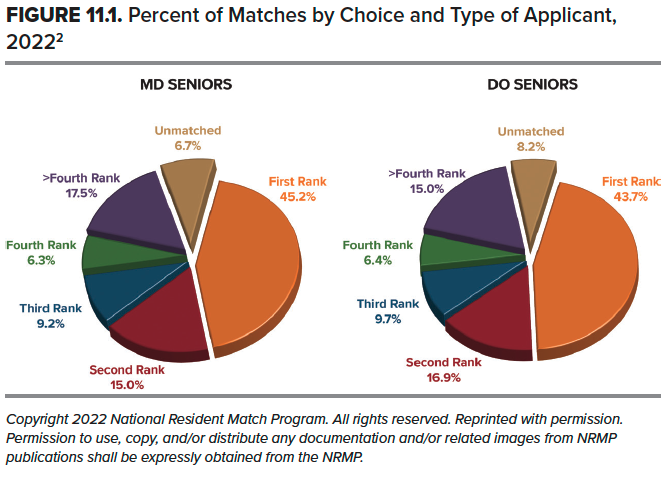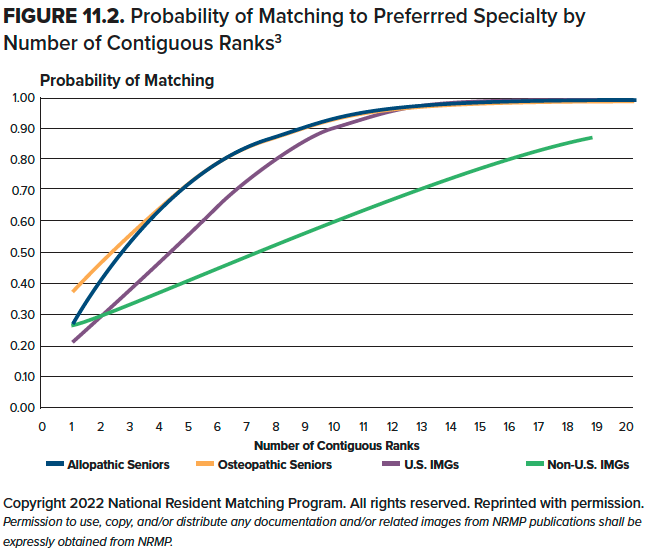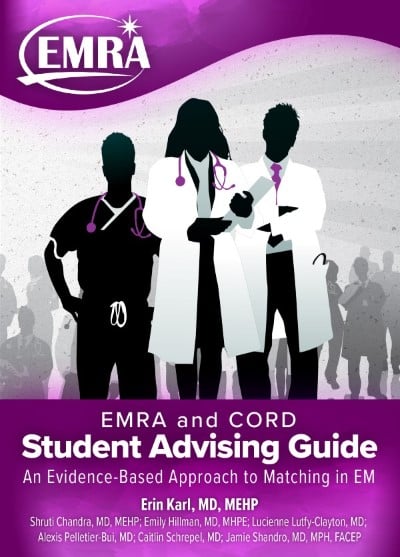Ch. 11 - Preparing and Submitting Your Rank List
While navigating the interview season, you should always be thinking about your rank list — comparing and contrasting programs as you go. Create a working list with comments, highlights, and pitfalls, and update it in order of preference after each interview. In doing this, you can place the program you just interviewed with in real-time where it stands in relation to others, all while keeping meaningful notes about your thoughts and feelings in an organized fashion.
How Does the Match Work?
At the end of interview season, applicants submit a rank-order list of the programs at which they interviewed (and would want to match), from their top choice to least preferred. Similarly, each residency program submits a list of interviewed applicants in order of matching preference. From there, a Nobel Prize-winning algorithm goes to work to find “stable marriages” between applicants and programs. The “stable marriage problem” is well-known in the fields of mathematics, economics, and computer science and is considered solved when there is no pair of matches by which both a program and an applicant would be better off than they are currently matched.1
Picture this: You rank a program No. 1, and your No. 1 program has 12 spots available for interns. If that program ranks you in any of their top 12 positions, a match is made (hooray!), and you will not be considered for matches at any other programs. Alternatively, you could also match at this program even if you were lower on their list; for example, let’s say they ranked you 20th, but eight applicants ahead of you ranked and were matched at different programs higher on their lists — you would still match at your top choice!
To see a live example of a simulated match between five applicants to two hospitals with two positions each, visit NRMP.org/matching-algorithm.
It is critical to understand the NRMP algorithm favors your preferences as the applicant. You should rank programs in the order in which you would truly prefer to match. Do not try to “game” the system and rank programs based on where you think you fall on their lists. Despite yearly circulating rumors, there is no gaming the algorithm. Similarly, expressions of interest from a program are not binding — and should be interpreted with caution. Again, always rank programs in your true order of preference. The first program you rank should be your top choice, even if you think it’s a reach. Conversely, do not rank a program high on your list just to see if you can match there if it’s not truly where you want to end up.
Overall, three-quarters of matched U.S. senior applicants will match at one of their top three choices. For those only applying to EM (not dual applying), the match rate was 98.9% for U.S. MD seniors and 97% for U.S. DO seniors in 2022. Across all specialties in 2022, 6.7% of U.S. MD seniors and 8.2% of U.S. DO seniors did not match to any location on their rank list. Chapter 12: What If I Don’t Match? explains what to do in that case.2

Couples Match: To participate as a Match-bound couple, both applicants must be entering the same match cycle and pay a “couples fee.” The NRMP does not define who can couples match — you can couples match with a friend, spouse, partner, sibling, or anyone else who agrees to create a paired rank list with you. For more information, visit NRMP.org/couples-match-videos.
How to Build Your List—What Matters to You?
There is no easy answer or correct way to build your rank list; the “right way” is based on what is right for you. How a training program fits for you, and how you fit in a training program, means many different things to different people. Several factors play a role in this.
Reflect on your professional and personal goals when prioritizing your list. Identify the priorities that matter most to you when comparing programs to rank. Envision yourself at each of these places of training over the next few years. SeeChapter 4 — Finding Your Fit: Learning the Landscape of EM for a list of factors that differentiate programs from one another. Some common elements to consider include:
- Length of training (3- vs. 4-year program)
- Location of training (geographic location, state, surrounding cities, climate)
- Programs' affiliated hospitals
- Residency rotation curriculum
- Flexibility of elective time
- Culture of the program, training environment, and support system(s)
- Academic vs. community vs. county setting
If you have already identified interest in potential fellowship training, it may be wise to weigh EM residency programs at sites that have fellowship opportunities more heavily. The flexibility and amount of elective time in residency may also be important if you harbor fellowship goals because it will facilitate dedicated scholarly time and research that will help you prepare for future fellowship applications. Envisioning your future of working at a academic vs. community vs. county hospital or rural vs. metropolitan environment should also be considered in your ranking of programs, as each of these experiences brings uniqueness to each program and training site.
Couples Match: Prepare your rank lists separately and then together. As a couple, discuss your priorities (same institution, same city, geographic distance, both partners matching at his/her/their top choice, etc.). Are you willing to have one partner go unmatched? Each partner can submit up to 300 ranks, which sounds like a lot, but the combinations add up rapidly. Avoid making a rank list that would produce any matches in which one partner will be unhappy.
How Many Programs Should I Rank?
Most would agree an applicant should rank all of the programs at which they interview, with rare exceptions. Consider carefully before choosing not to rank a program. On one hand, it is risky to include a program where you would not be happy training because The Match is binding for both applicants and programs. On the other hand, going unmatched puts you in a much more challenging position if you wish to pursue a career in EM.
Historically there were few to no positions that went unfilled in the EM Match, so “scrambling” (now called SOAPing; seeChapter 12) into a position after The NRMP Match was unlikely. However, in 2022 there were 219 unfilled positions in EM, prior to the SOAP,2 and that number more than doubled in 2023. It is hard to know if unfilled positions in EM will be an ongoing trend. Even though SOAPing into unfilled positions might be an option, these numbers can change from year to year. Thus, review the NRMP post-Match results/data from prior years and discuss application strategies with your EM advisor
Again — only leave a program off your rank list if you would rather train in a specialty other than EM or not match at all than train there (hence, the rare exceptions). A program that you weren’t sure about on interview day might surprise you when you arrive to train there. Most EM residency programs will lead you to the end goal of becoming a competent emergency physician. It will nearly always be better to be matched and move forward with your career path than go unmatched with a gap year without structured clinical experience and patient care. Not to mention, entering into a second Match cycle can be extremely daunting and trying for reapplicants.
As mentioned in Chapter 9—Interview Season Logistics, except for non- U.S. IMG applicants, ranking 11-12 programs will give you a > 95% chance of matching. The NRMP’s Interactive Charting Outcomes in the Match tool and its ranking guidelines can be very helpful as you determine how many programs you need to rank to match and how to rank them, based on your individual competitiveness.3,4 With the backing of this objective data, it is strongly recommended to not “hoard” interviews, as almost all of these will later appear on your rank list. With a 100% match rate into EM for all U.S. MD and DO seniors with at least 11 ranks in 2022, accepting greater than 14 interviews could very well be considered a faux pas to your peers and future colleagues.

Military Match: MODS will allow you to rank five programs. Given the limited number of spots in the military match, you should rank ALL military programs where you interview.
At-Risk Candidates: Rank ALL programs where you interviewed. If you did not interview at enough programs to attain a high likelihood of matching, you have hopefully already developed a proactive backup plan with your academic advisor to SOAP or apply to a second specialty or transitional internship. Preparation is the key to success.
How Do I Submit My Rank List?
Creating your NRMP rank list requires creating registering for the Match at NRMP.org, starting in mid-September with a deadline of late January. This is a different registration process than ERAS; however, it will be linked after establishing an account on both websites. If you have trouble with registration, contact the NRMP help desk or ask your medical school advisor for assistance. Resources abound at NRMP.org, including tutorials and videos explaining every step of the process. It is also important to check the NRMP website for the specific deadlines for the year you are applying.
In January or early February of your Match year, you can start to rank programs in the NRMP’s Registration, Ranking, and Results (R3) system. This website will use your credentials obtained when you registered in the fall. Make sure you have the correct program identification numbers when you enter your rank list. Some schools/residencies have multiple program codes for different types of applicants and locations. You will then enter the programs into the R3 system in your order of preference. This is where your nifty list you’ve been keeping updated all interview season becomes exceptionally handy.
After you enter your rank preferences, you will need to certify your list. You must certify your list BEFORE the ranking deadline in late-February/early March to have it officially available for matching purposes. You will receive a confirmation email and see the status of your list change to “certified” when you have done this. You can re-rank and re-certify as many times as you want up until the NRMP’s Rank Order List certification deadline! Certify your list each time you make changes so you will always have an updated certified list in the system. The R3 system does not save old versions of your rank list. As always, do not wait until the final hours to submit and certify, nor login with last-minute jitters to make large (and often irrational) changes. Currently, you are allowed 20 ranked unique programs before you have to pay additional (non-refundable) fees.
Help! Whom Should I Talk To?
Ask friends, parents, significant others, or objective third parties to help you talk through the programs in which you’re interested or to help identify your priorities. If you’re bringing a significant other along during residency, deeply consider their input and be sure the locations you prioritize will also have opportunities for them. You should also consult with your advisor to understand how different options may affect your career path. Picture yourself living and training at each of these places for the next several years because it will soon become a reality!
Consider having a pretend Match Day:
- Place all programs at which you interviewed in a bowl.
- Have a friend pull a program out of the bowl and read the residency name out loud.
- How did you feel when that name was read? Ask your friend about their perception of your reaction to each program.
- If you are taking notes or using a spreadsheet, record your thoughts/responses next to each program.
- If you are still unsure, “try on” a few programs and exercise your imagination. For one day, pretend you matched at Program A and see how you feel. Then the next day pretend you matched at Program B. This may help clarify your true preference.
Once you have certified your final rank list, your work is done — and the waiting begins. Take a deep breath. Your many hours of hard work will soon be validated. It’s not uncommon to feel a rollercoaster of emotions about your rank list as you count down toward Match Day. Acknowledge them and reward yourself for achieving everything that you have to this point. A whole new journey is closer than you know.
The Bottom Line
- Start a draft of your rank list during the interview season, and keep notes as you go. This will help organize your thoughts in finalizing and certifying your list.
- Consider your priorities in a training program, what you truly value, and what your ideal future as an EM physician will look like.
- With rare exceptions, it is to your advantage to rank all programs where you interview.
- Understand the NRMP Match algorithm favors applicant preferences, so develop your rank list according to your true preference rather than trying to “game” the system based on what you think programs might do.
References
- How Long Does the Residency Match Algorithm Take to Run? 2015. https://medium.com/@vishnuravi/how-longdoes-the-residency-match-algorithm-take-to-run-c38c06cd4d57.
- National Resident Matching Program. Results and Data: 2022 Main Residency Match. 2022. https://www.nrmp.org/wp-content/uploads/2022/05/2022-Main-Match-Results-and-Data_Final.pdf.
- National Resident Matching Program. Interactive Charting Outcomes in the Match. http://www.nrmp.org/interactive-chartingoutcomes-in-the-match/.
- National Resident Matching Program. Ranking Residency Programs. http://www.nrmp.org/ranking-residency-programs/.





